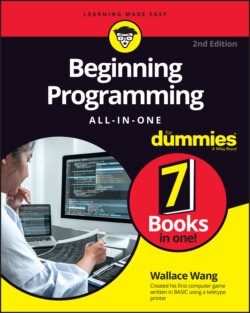Читать книгу Beginning Programming All-in-One For Dummies - Wallace Wang - Страница 8
ОглавлениеIntroduction
If you enjoy using a computer, you may have even more fun learning to control a computer by writing your own programs. To learn how to program a computer, you need to:
Understand that computer programming is nothing more than problem solving. Before you even think about writing a program, you need to know what problem you want your program to solve and how it will solve it.
Learn the basic ideas behind computer programming that work with all programming languages on any computer. Although programming a Windows computer is different from programming a Mac, a smartphone, a smart watch, or a super computer, the general principles remain the same. By learning what these common programming principles are and why they exist, you can learn different ways to tell a computer what to do, step-by-step.
Learn a specific programming language. A programming language represents just one way to express your ideas in a language that the computer can understand. By combining your knowledge of a programming language with programming principles and the type of problem you want the computer to solve, you can create your own computer programs for fun or profit.
About This Book
If you have any interest in programming but don’t know where to start, this book can give you a nudge in the right direction. You won’t learn how to write programs in a specific programming language, but you’ll learn the basics of computer programming so you’ll have no trouble learning more on your own.
If you already know something about programming, this book can still help you learn more by introducing you to the variety of programming languages available and make it easy for you to pick up different programming languages quickly. The more you understand the advantages and disadvantages of different programming languages, the better you’ll be able to choose the language that’s best suited for a particular task.
Whether you’re a novice or an intermediate programmer, you’ll find this book can work as a tutorial to teach you more and as a reference to help refresh your memory on programming topics you may not normally use every day. This book won’t turn you into an expert overnight, but it will open the doors to more information about programming than you may have ever known even existed.
This book is a reference — you don’t need to read the chapters in order from front cover to back and you don’t have to commit anything you read here to memory. Also, sidebars (text in gray boxes) and anything marked with the Technical Stuff icon are skippable.
Finally, within this book, you may note that some web addresses break across two lines of text. If you’re reading this book in print and want to visit one of these web pages, simply key in the web address exactly as it’s noted in the text, pretending as though the line break doesn’t exist. If you’re reading this as an e-book, you’ve got it easy — just click the web address to be taken directly to the web page.
Foolish Assumptions
When writing this book, I made two assumptions about you, the reader:
You may have no experience in computer programming or a limited amount of experience, but you’re eager to learn.
You have a computer (whether it’s the latest model on the market or simply an older model that still works). Ideally, your computer can connect to the Internet.
That’s it! As long as you have a computer and the desire to learn, you have everything you need to learn computer programming.
Icons Used in This Book
Icons highlight important or useful information that you may want to know about. Here’s a guide to the icons:
The Tip icon highlights information that can save you time or make it easier for you to do something.
The Remember icon emphasizes information that’s so important you should commit it to memory.
Look out! The Warning icon highlights something dangerous that you need to avoid before making an irreversible mistake that could make you curse your computer forever.
The Technical Stuff icon highlights interesting technical information that you can safely ignore, but which may provide additional background about programming a computer.
Beyond the Book
In addition to what you’re reading right now, this product also comes with a free access-anywhere Cheat Sheet that summarizes different types of programming principles, common ways to store and organize data, and lists of suggested software to use. To get this Cheat Sheet, simply go to www.dummies.com and type Beginning Programming All-in-One For Dummies Cheat Sheet in the Search box.
Where to Go from Here
You can use this book as a tutorial or a reference. Although you can just flip through this book to find the information you need, programming novices should start with Book 1 before tackling any other books. After you understand the basics of programming from Book 1, you can freely jump around to read only the information that interests you.
Programming is more than learning a particular programming language or even knowing how to program a particular type of computer. Basically, programming is about tackling difficult problems and breaking them down into smaller problems until you ultimately solve one much bigger problem. If you like the idea of solving problems, this may be the perfect book to introduce you to the wonderful world of computer programming!
